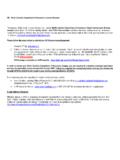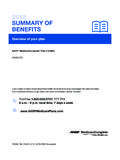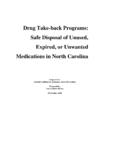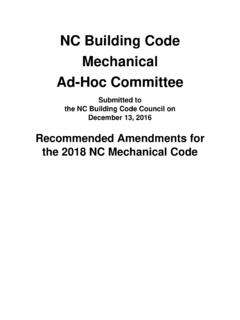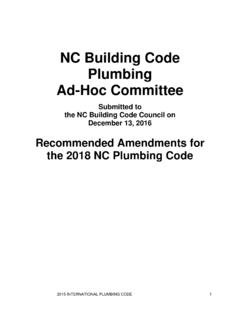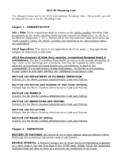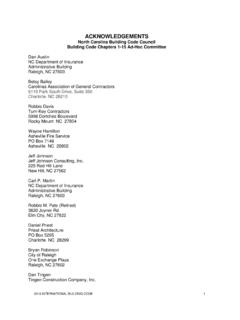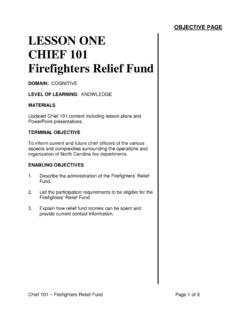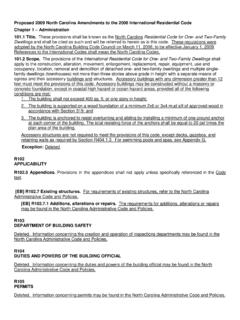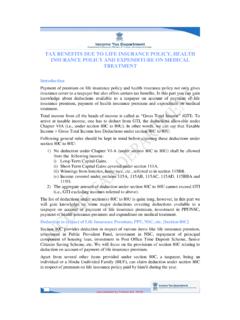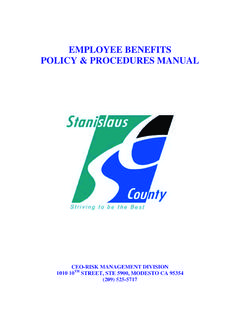Transcription of A CONSUMER’S GUIDE TO LIFE INSURANCE - NCDOI
1 A CONSUMER S GUIDE TOLIFE INSURANCELife INSURANCE Options ..1 Why Buy life INSURANCE ..1 Term life INSURANCE ..1 Permanent life INSURANCE ..2 Term life and Permanent life INSURANCE Comparisons ..3 Standard policy Provisions ..4 Optional Riders ..5 Shopping for life INSURANCE ..5 Applying for life INSURANCE ..9 Collecting Death Benefits ..10 Before and After Your Purchase ..12 Frequently Asked Questions ..12 Consumer Services Division Information ..13 life INSURANCE Needs Worksheet ..14 TABLE OF CONTENTSN orth Carolina Department of INSURANCE 1201 Mail Service Center Raleigh, NC 27699-1201 You can find additional information as well as a downloadable copy of our Request for Assistance form on the NCDOI Web you have questions, the Consumer Services Division of your North Carolina Department of INSURANCE is here to : 919-733-0085 Toll free: Department of INSURANCE | Mike Causey, CommissionerGLOSSARY OF INSURANCE TERMSEVIDENCE OF INSURABILITYP roof that a person is an acceptable risk to the INSURANCE company.
2 FACE VALUE (FACE AMOUNT)The initial amount of death benefit provided by the policy . The actual death benefit may be higher or lower depending on the options selected, outstanding policy loans or premium INTERESTThe likelihood that a genuine loss would occur to the beneficiary/owner of a life INSURANCE contract in the event of the insured s death. LAPSET ermination of a policy because of failure to pay the TABLEA statistical table showing the probability of death at each printed contract issued to the policyowner which sets forth and states the terms of amount paid for an INSURANCE restoration of a lapsed policy to its original premium-paying status. The company may require evidence of insurability and all past due premiums plus cancellation of a policy for its cash CHARGESC ontractual charges imposed by an INSURANCE company in the event of early policy person who reviews applications for INSURANCE and decides if the applicant is an acceptable risk to the life INSURANCE is not the same.
3 life INSURANCE can be divided into two basic categories term and permanent . Term life INSURANCE provides coverage for a specific period of time, while permanent life INSURANCE provides coverage for the insured person s entire life . Both types pay what is known as a death benefit, which is the amount of money paid out upon the insured s death. This money is paid to the person or persons designated by the insured. These people are known as the following pages explain the features of term and permanent life INSURANCE policies, and also compare the two so you can better understand what each type of coverage offers. Later in this GUIDE you will find a worksheet to help you evaluate your needs and choose a policy type that meets those always, if you have questions about the types of life INSURANCE available, you can call the Department of INSURANCE at a loved one dies, the surviving family members face many unexpected expenses.
4 In addition, the deceased may have been a primary earner for his/her family, and the loss of that income can be devastating. How will the family pay the mortgage and the car payments? Will there be enough money for the child s college or other educational expenses? What about credit card debt or other debts the family still has to pay?The proceeds from a life INSURANCE policy can go a long way towards stabilizing a family s finances. Immediate expenses can be covered and debts can be met. Long term financial needs, such as educational expenses, can be covered and mortgages can be paid off. In short, the proceeds of life INSURANCE can help replace the deceased s income and provide financial assistance to the loved ones left INSURANCE OPTIONS |||||||||||||||||||||||||||||||||||||||| ||||||||||||||||||||||||||||||||||DO I REALLY NEED life INSURANCE ?
5 |||||||||||||||||||||||||||||||||||||||| ||||||||||||||||||Term life is the simplest form of life INSURANCE . It provides a pure death benefit. The policy will cover the insured for a specified period of time (the term ), such as 10 or 20 years, or until a specified age. If you purchase term life INSURANCE at a younger age, you can usually buy more at a lower INSURANCE generally does not build a cash value. At the end of the term period, the policy typically terminates without any remaining benefits or monetary value. Term INSURANCE is ideally suited to cover specific needs that may decrease or disappear over TERM life INSURANCE FEATURESF ollowing are two common provisions of term INSURANCE policies you may wish to consider during the purchase of a term life INSURANCE Renewable Privilege allows the insured to renew the policy without having to prove insurability.
6 (You do not have to be in good health.)Conversion Privilege guarantees the insured the right to convert a term policy to a permanent policy , without having to prove insurability. TERM life INSURANCE |||||||||||||||||||||||||||||||||||||||| |||||||||||||||||||||||||||||||||||||||| 2 PERMANENT life INSURANCE |||||||||||||||||||||||||||||||||||||||| |||||||||||||||||||||||||||||TYPES OF TERM life INSURANCET here are three major types of term life INSURANCE : Level The death benefit stays the same throughout the policy term and premiums typically remain The death benefit increases by specific amounts and at intervals as specified in the policy . Premiums normally increase along with the The death benefit decreases periodically as specified by the policy . Premiums typically remain constant throughout the policy life INSURANCE is designed to provide protection for the entire life of the insured person, as long as the premiums are paid.
7 There are many different versions and variations of permanent INSURANCE . FEATURES OF PERMANENT INSURANCEP ermanent INSURANCE offers some features that are different than those found in term life INSURANCE policies. Cash Value The cash value is an amount available to a policyowner if the policy is canceled (surrendered). Cash value may also be used as collateral on a policy loan. Cash value generally increases over time as premiums are paid. policy Loans A policyowner may borrow an amount up to the maximum loan value of the permanent policy . Loan interest will be charged in accordance with the policy provisions. The loan may be paid back in a lump sum or installments. If at any point the amount of the loan plus interest exceeds the policy s cash surrender value, the policy may be terminated without further value. At the insured s death, any outstanding loan and interest will be deducted from the death benefit.
8 Participating versus Non-Participating Participating policies may pay dividends. Non-participating policies do not. Dividends are refunds of the INSURANCE company s excess or unused premiums. Dividends are not usually distributed until the second policy year; however, they are never are typically several available dividend options, such as:Cash Payment The dividend can be paid directly to the policyowner in Reduction The dividends can be used to pay part of the premium. The INSURANCE company will send a statement showing the amount of the dividend and balance of premium due, if any. Interest Option (Left on Deposit) The dividends can be left with the INSURANCE company to earn interest. All or part of this money may be withdrawn at any Year Term This option allows for the purchase of one year term INSURANCE that will be payable in addition to the face amount of the policy .
9 Paid-up Additions The dividends can be used to purchase paid-up additional life OF PERMANENT life INSURANCEP ermanent INSURANCE is available in a variety of forms, including:TRADITIONAL WHOLE LIFEThis policy , sometimes called ordinary life or straight life , covers the insured for life as long as premiums are paid. This is the most basic permanent policy . Typically, the premium remains the same throughout the life of the insured. Some variations of these policies permit the premiums to be paid for a shorter period, such as 10 years, 20 years or until age 65. UNIVERSAL LIFES ometimes referred to as Flexible Premium Adjustable life , this policy is more flexible than a traditional whole life policy . Premium payments may vary within certain limitations stated in the policy . For example, premium payments may be increased, decreased or skipped altogether, as long as the policy s accumulated value remains sufficient to keep the policy in force.
10 Also, the death benefit may be raised or lowered more easily with universal life than with a traditional whole life life policies are interest sensitive, meaning the accumulated value earns interest. Reduced interest rates may require additional premiums to maintain the policy in force. Make sure you understand which values are guaranteed by the contract and which are not. Universal life policies are appropriate for individuals who need the guarantees provided by a whole life policy , but want the possibility of earning higher rates of interest on their policy values. VARIABLE LIFEV ariable life differs from traditional whole life and universal life INSURANCE in that the policyowner chooses how to invest the policy s accumulated value. There are typically a variety of choices for allocating the funds, including stock, bond, and money market accounts.

